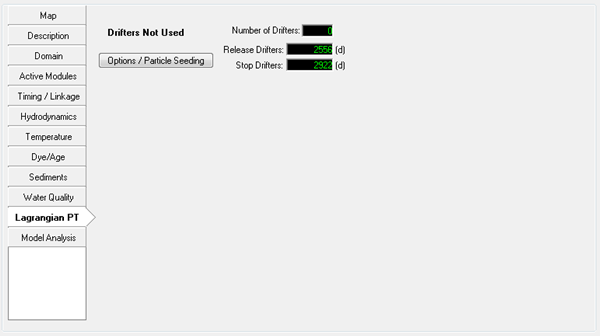Lagrangian Particle Transport (LPT)
EFDC_Explorer has been updated to incorporate the pre- and post-processing of LPT's (Dang Huu Chung and P.M.Craig. 2009). Use of LPT's can be helpful when modeling oil spill tracks, emergency response, water quality applications and plume tracking. The Lagrangian Particle Tracking tab is shown in Figure 1.
Figure 1 Lagrangian Particle Tracking Tab.
The EE pre-processing provides full control for initial particle seeding, LPT computational option selection and plotting. The EE post-processing allows for a range of display options for the tracks, animations to the screen and or AVI files, and the ability to export any or all of the particle tracks to ASCII files.
The LPT sub-model has been implemented with the following major options:
- Particles are free to move in full 3D,
- Particles can be fixed at a user specified depth, and
- A random walk component can be added to either of the two options above.
The numerical solution was separately divided into the advective transport and random components. This approach allows the user to enable (i.e. turn on random walk) or disable (advective transport only) the random components for either the horizontal and/or the vertical directions.
The method used for the solution of the differential equations is the Runge-Kutta 4 method: This method has the approximation of O(∆t4). It has been determined that the Runge-Kutta 4 method is preferred due to its higher level of numerical accuracy. It has been shown that the computational burden of the Runge-Kutta 4 method is not significant within the overall model run times compared to other methods tested.
Within the Lagrangian Particle Tracking Options/Drifters frame (Figure 1) is reported the number of drifters set, the time for release of the drifters and the end time for the observation of the drifters. In order to set the values related to the drifters the user should select the Options/Particle Seeding button. This displays the various options for setting the drifters as described below.
